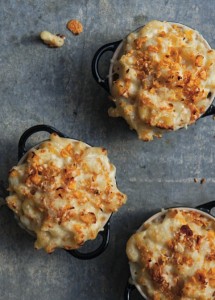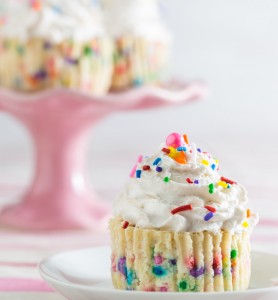The Chef’s Table: New Twists on Traditional Dishes for Your Chanukah Celebrations
These family-friendly dishes are perfect for any occasion, especially for Chanukah. They are creative, look fantastic, taste scrumptious—and they’re fairly easy to make. Old classics prepared with new flair, these delicious, diverse dishes come from three of today’s best-selling cookbook authors. Their culinary creations are sure to lighten up the mood when the weather turns chilly. Small bites, big flavors—these dairy dishes are sure to please the fussiest of eaters at your Chanukah celebrations!
Individual Mac N’ Cheese (Dairy)
Adapted from The New Kosher by Kim Kushner
(Weldon Owen Publishers)
Serves 8
Cookbook author and instructor Kim Kushner loves to serve this recipe, adapted from The Fannie Farmer Cookbook, because it’s simple and classic. Kim adds many things to her version to vary it: pesto, red pepper flakes, truffle oil and toasted sesame oil, to name a few. Also, let’s face it, macaroni and cheese is no longer just for kids. The dish has become the “it” food all over town. She prepares it in individual baking dishes or ramekins, so each guest gets his or her own bubbly and crisp serving right out of the oven. No ramekins? Just use an oblong baking dish.
4 Tbsp (2 oz/60 g) unsalted butter, plus butter for greasing dishes
1 package (8 oz/250 g) macaroni or other small pasta
1/4 cup (1 1/2 oz/45 g) all-purpose flour
Kosher salt and freshly ground black pepper
1 cup (8 fl oz/250 ml) whole milk
1 cup (8 fl oz/250 ml) heavy cream
2 cups (8 oz/250 g) shredded cheddar cheese or
shredded cheese of your choice
1/2 cup (2 oz/60 g) cornflake crumbs
Red pepper flakes, truffle oil, pesto, or toasted sesame oil for topping
1. Preheat oven to 400°F (200°C). Butter eight 1/2-cup (4-fl oz/125-ml) ramekins or 9-by-12-inch (23-by-30-cm) baking dish.
2. Bring a pot of salted water to a boil over high heat. Add the macaroni, stir well, and cook for a few minutes less than the package directions. Drain and set aside.
3. In a large saucepan, melt the butter over medium heat. Add the flour, 1/2 teaspoon salt, and a sprinkle of black pepper and whisk to stir until well blended. Gradually pour in the milk and cream while stirring constantly. Bring to a boil and boil, stirring, for 2 minutes. Reduce the heat to medium and cook, stirring, until the sauce thickens, about 10 minutes longer. Add the cheese little by little and simmer, stirring, until melted, about 5 minutes. Remove from the heat.
4. Transfer the macaroni to a large bowl, pour in the cheese sauce, and toss to coat evenly. Transfer to the prepared baking dishes and sprinkle with the cornflake crumbs. Bake until the top is golden brown, about 20 minutes for individual ramekins and 35 minutes for the baking dish. Just before serving,
sprinkle with the red pepper flakes or other topping.
5. To make in advance, let cool completely, then cover with plastic wrap and freeze for up to 1 month. Thaw in the fridge overnight and reheat in a preheated 325°F (165°C) oven for 20-25 minutes before serving.
Sweet Potato and Butternut Squash Mini-Latkes with Labneh (Dairy)
Adapted from The Seasonal Jewish Kitchen by Amelia Saltsman (Sterling Epicure)
Yields 48 mini-latkes, 8 to 12 appetizer servings; or 18 to 20 large latkes, 6 servings
These bright pancakes are sweet, spicy and salty, and when made mini-size, they are a good appetizer that wakes up the taste buds. Sweet potatoes tend to burn easily because of their high sugar content, but that problem is remedied by including less sweet butternut squash, which also makes more tender pancakes. In The Seasonal Jewish Kitchen, Amelia Saltsman draws on her rich food history to bring her readers a fresh take on tradition, through her trademark seasonal spins on beloved favorites in a yearlong culinary journey inspired by the Jewish calendar. Latkes anyone?
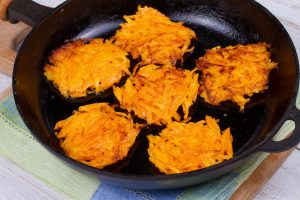 1/2 lb (225 g) sweet potatoes, peeled or scrubbed
1/2 lb (225 g) sweet potatoes, peeled or scrubbed
1/2 lb (225 g) butternut squash, peeled
1 small onion
2 eggs, beaten to blend
2 heaping Tbsps unbleached all-purpose flour or potato starch
1 tsp kosher salt
1/4 tsp baking powder
A few drops Tabasco
Mild oil with a medium-high smoke point, such as grapeseed, sunflower, or avocado, for pan-frying
Labneh, homemade (see below) or store-bought
Smoked salt or other finishing salt
1. Using the large holes of a box grater or a food processor fitted with a grating disk, grate the potatoes and squash into a large bowl. You should have about 4 cups (400 g) total. Grate the onion into the bowl the same way. You should have about 1/3 cup (50 g) pulp; mince or discard any large onion pieces. Stir in the eggs, flour, salt, baking powder, and Tabasco.
2. Line 2 or 3 baking sheets with paper towels. Have the prepared pans, the latke batter, a large spoon, and a spatula near the stove. Heat 1 or 2 large skillets over medium heat. Generously film the pan(s) with vegetable oil (not more than 1/4 inch/6 mm deep). When the oil is shimmering in the pan (a tiny bit of batter dropped into it should sizzle on contact), start spooning in the latke batter by the level tablespoon, making sure to add both solids and liquid. Flatten each spoonful with the back of the spoon into a circle 2 to 3 inches (5 to 7.5 cm) in diameter. Do not crowd the latkes in the pan. You’ll get 6 to 8 mini-latkes in a 12-inch (30.5-cm) skillet. If making large latkes, use twice as much batter for each latke and cook only 4 or 5 latkes in the pan(s) at a time.
3. Cook the latkes, flipping them once, until golden on both sides, about 5 minutes total. Transfer the latkes to a prepared baking sheet. Cook the remaining batter in the same way, always stirring the batter before adding more to the pan and adding oil as needed to the edge of the pan. The latkes can be made a few hours ahead and reheated in a single layer on baking sheets in a 350°F (180°C) oven.
4. To serve, arrange latkes in a single layer on a platter and top each latke with a dollop of labneh and a little finishing salt. Or, pile latkes on a platter and accompany with bowls of self-serve condiments.
Labneh
Yields 2 cups
Labneh is a lightly salted and drained cow’s, sheep’s or goat’s milk yogurt that becomes tarter, thicker and creamier in the process of removing the liquid. Cookbook author Amelia Saltsman suggests that you try a “shmear” of labneh instead of cream cheese on bagels. Labneh continues to thicken the longer it drains; after two days, it will be firm enough to roll into balls and marinate in olive oil and herbs, which will keep for a couple of weeks. Commercial labneh is available at supermarkets and Middle Eastern groceries, but it’s hard to beat the homemade version, which has no thickeners or stabilizers. Cheese and olive oil are two symbolic foods for Chanukah.
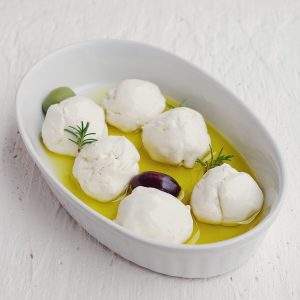 2 lb (900 g) plain yogurt, either whole milk or low-fat
2 lb (900 g) plain yogurt, either whole milk or low-fat
1/2 tsp salt
Za’atar for rolling balls
Olive oil for covering balls
1. Stir together the yogurt and salt. Line a fine-mesh sieve with several layers of cheesecloth (or 1 layer of kitchen muslin) large enough so that the ends overhang the sieve. Rest the sieve over a bowl. Spoon the yogurt into the sieve, then cover with the ends of the cheesecloth. Refrigerate for at least 6 hours or up to 24 hours.
2. Scrape labneh into a bowl, cover tightly, and refrigerate for up to 4 days. Discard the whey or refrigerate it and use to thin and add tartness to soups.
3. Alternatively, drain the yogurt until it is stiff enough to roll into balls, 2 to 3 days. Roll into 1- to 2-inch (2.5- to 5-cm) balls, roll the balls in za’atar, and place in a clean jar. Pour in olive oil to cover. Cap tightly and refrigerate for up to 2 weeks. Bring to room temperature to serve.
Bakery Style Cake Donuts (Dairy or Pareve)
Adapted from Something Sweet by Miriam Pascal
(ArtScroll/Mesorah Publications)
Yields 18-20 donuts
If you read “cake donut” and think “baked donut,” think again. Miriam Pascal’s delicious donuts are made using dough similar to a cake batter, which utilizes baking powder instead of yeast to rise. So if you’re intimidated by yeast (and even if you’re not), you’ll appreciate the simplicity of this recipe. These donuts stay fresher longer than yeast donuts. Sufganiyot, American-style!
 2 eggs
2 eggs
3/4 cups sugar
1 Tbsp baking powder
1/4 teaspoon nutmeg
1 teaspoon vanilla extract
3 3/4 cups flour
3/4 cup milk or soy milk
1/4 cup oil
Oil for frying
Glaze, optional (see below)
1. In the bowl of an electric mixer, on medium speed, beat together eggs and sugar until smooth and creamy, 2-5 minutes. Add baking powder, nutmeg, and vanilla; beat to combine.
2. Reduce mixer speed to low. Add one-third of the flour, followed by the milk, followed by another third of the flour; add oil, then remaining flour. Beat until a sticky dough forms. Refrigerate dough until firm, 1-2 hours or up to overnight.
3. Remove dough from the fridge (the dough will not rise until it is fried). Place it on a heavily floured surface. The dough will still be somewhat sticky, so it’s important to use plenty of flour to roll it out.
4. Roll dough out to about 1/4-inch thickness. Using a cookie cutter or the rim of a glass, cut out dough circles; then, with a smaller cutter or glass, cut a small circle from the center. Carefully pick up each donut to make sure it retains its shape. Reserve the small circles to fry as donut holes (see Variation).
5. Heat about 2 inches of oil in a medium saucepan or deep fryer over medium heat. Test the oil by dipping a donut into the oil; when ready, it will start to bubble immediately.
6. Fry 2 or 3 donuts at a time. Wait until you see the golden brown color start to creep up the side of the center before turning donuts. This will take about 1 to 1 1/2 minutes. Flip the donuts and fry until golden brown on the other side, about a minute.
7. Remove from oil; drain on a paper towel-lined plate. Allow to cool slightly before glazing, optional.
Note: For Chanukah, Miriam Pascal likes to serve these donuts on a “donut bar.” Prepare a variety of glazes; present them in small cups or jars. Set out a variety of sprinkles, cookie crumbs, chopped nuts, and other toppings. Serve the donuts and let your guests enjoy creating their own flavor combinations.
Variation: To make Cinnamon-Sugar Donut Holes: Combine 4 teaspoons sugar with 1 teaspoon cinnamon. Fry the small dough circles in hot oil for about 30 seconds per side. Remove from oil and roll hot donut holes in sugar mixture. Set aside to cool.
Plan Ahead: These donuts are best fresh from the pan, and should ideally be eaten within the first few hours; however, they are still great the next day. Do not freeze.
Three Easy Glazes (Dairy or Pareve)
These are just three of the easy glazes that Miriam Pascal suggests in her new baking cookbook, Something Sweet (ArtScroll/Mesorah). This should be enough to get you started. If you feel that your glaze is too thin to hold up well or too thick to drizzle, add a little more powdered sugar or liquid, respectively, to attain the perfect texture. Each glaze yields enough to glaze a whole lot of donuts (or one standard cake).
Vanilla Glaze
1 cup powdered sugar
1 Tbsp light corn syrup or honey
1 Tbsp milk or soy milk
1/2 tsp vanilla extract
Combine all ingredients in a small bowl. Whisk until smooth.
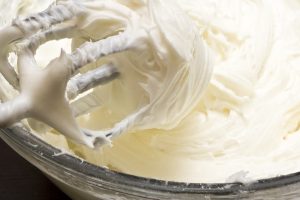 Cream Cheese Glaze
Cream Cheese Glaze
2 oz cream cheese or soy cream cheese
1 1/4 cups powdered sugar
1/2 tsp vanilla extract
1 Tbsp milk or soy milk
Combine all ingredients in a small bowl. Whisk until smooth.
Chocolate Glaze
1 cup powdered sugar
2 Tbsp unsweetened cocoa powder
2 Tbsp milk or soy milk
Combine all ingredients in a small bowl. Whisk until smooth.
Confetti Cheesecake Cupcakes (Dairy or Pareve)
Adapted from Something Sweet by Miriam Pascal
(ArtScroll/Mesorah Publications)
Yields 9-10 servings
These adorable little cheesecakes make a great party treat. They’re kid-friendly thanks to the color, and adult-friendly thanks to the great flavor! Bonus: They’re really easy to make!
9-10 vanilla sandwich cookies
8 oz cream cheese or soy cream cheese
1/3 cup sugar
2 eggs
1 tsp vanilla extract
1/3 cup colorful sprinkles
Topping:
1/2 cup heavy whipping cream or nondairy whipped topping
1/4 cup powdered sugar
Sprinkles, optional, for decorating
1. Preheat oven to 350°F. Line a cupcake pan with paper liners (you will only need 9-10). Place a sandwich cookie into each liner.
2. In a small bowl, whisk together cream cheese, sugar, eggs and vanilla until smooth. Add sprinkles; stir gently to distribute evenly.
3. Divide filling between prepared liners. Bake for 17-18 minutes, or until tops are set. Set aside to cool completely.
4. Prepare the topping: Whip cream until stiff peaks form. Stir in powdered sugar. Place topping into a piping bag; pipe over cooled cheesecakes.
5. Decorate with remaining sprinkles.
Variation: For cookies ’n cream cheesecake cupcakes: Substitute chocolate sandwich cookies for the vanilla cookie base. Substitute 1/3 cup chocolate sandwich cookie crumbs for the sprinkles.
Plan Ahead: These mini cheesecakes freeze well in an airtight container or zip-lock bag. For best results, freeze them without the whipped cream topping; add it just before serving.
Norene Gilletz of Toronto, Canada, is the author of ten cookbooks, including The NEW Food Processor Bible: 30th Anniversary Edition (Whitecap). Norene is the co-author of The Silver Platter: Simple to Spectacular with Daniella Silver (ArtScroll/Mesorah). Norene is a freelance food writer, culinary consultant, cookbook editor, lecturer and culinary spokesperson. She produces a kosher food line called Norene Gilletz Kitchen. For more information, visit www.gourmania.com.


